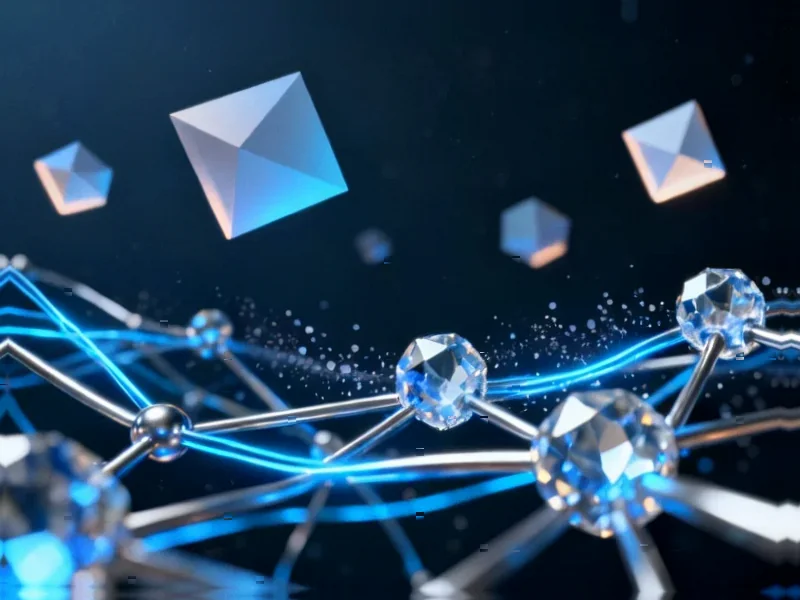Catalytic Breakthrough in Plastic Upcycling
Researchers have demonstrated a novel chemical recycling approach that converts waste polyacrylonitrile polymers into valuable nitrile compounds, according to a recent study published in Nature Communications. The method utilizes shuttle catalysis to transfer hydrogen cyanide (HCN) from discarded plastics to useful organic molecules, potentially creating new economic incentives for plastic waste recovery.
Table of Contents
Polymer-to-Chemical Conversion Mechanism
The process employs palladium/Xantphos and AlMe2Cl catalysis to facilitate transfer hydrocyanation reactions, sources indicate. Waste plastics including styrene-acrylonitrile (SAN) and acrylonitrile-butadiene-styrene (ABS) polymers serve as inexpensive HCN donors, generating synthetically valuable nitrile compounds from various olefins in quantitative yields. Analysts suggest this represents a significant advancement in chemical valorization of plastic waste.
Initial experiments using nickel-based catalysts proved ineffective, the report states, but switching to palladium catalysis dramatically improved results. Researchers achieved nitrile yields of 59% with SAN and 57% with ABS within 6 hours at 120°C. Lower molecular weight SAN polymers showed slightly better performance, with yields increasing from 59% to 65%.
Reversible Reaction System
The transfer hydrocyanation operates as an equilibrium system due to its near-ergoneutral nature (ΔG ~ 0), according to the research. Scientists verified reversibility by demonstrating that starting from either SAN with styrene or defunctionalized SAN with 3-phenylpropionitrile produced similar nitrile group distributions between polymer and small molecules.
The equilibrium can be strategically shifted using highly energetic HCN acceptors like norbornene and ethylene, the report states. When researchers used a 5-fold excess of polymer relative to styrene, yields increased dramatically from 60% to 95%, demonstrating the system’s tunability for practical applications.
Broad Synthetic Applications
The method successfully produced various nitrile products with high yields (up to 100%) and good regioselectivities, according to the findings. Functional groups including fluorine, chlorine, cyano, silyl, and alkoxy substituents were well tolerated, generating medicinally relevant building blocks. One compound (13) serves as a precursor for nabumetone, a nonsteroidal anti-inflammatory drug.
Non-activated cyclic and terminal olefins also proved effective substrates, producing multi-purpose chemical building blocks. The research indicates that controlling aluminum cocatalyst concentration is crucial for achieving desired product ratios, with low availability eroding linear-to-branched selectivity.
Complete Polymer Defunctionalization
When reversing reactant ratios to use polymer as the limiting reagent, scientists achieved near-complete dehydrocyanation, the report states. While styrene acceptors capped at 71% defunctionalization, norbornene drove the equilibrium toward practically full dehydrocyanation (100% for SAN, 97% for ABS).
More significantly, researchers optimized the system using ethylene as a feedstock acceptor, generating propionitrile—a versatile platform molecule used as a solvent and amine precursor. The reaction achieved 96% dehydrocyanation for SAN and 91% for ABS under 8 bar nitrogen and 4 bar ethylene pressure. Scaling to 7.5 mmol in a 60 mL reactor maintained high efficiency (94% defunctionalization).
Real-World Plastic Waste Application
The team tested the method on commercial LEGO bricks, which are primarily composed of ABS polymer, according to their analysis. Defunctionalization degrees closely matched those of pure ABS, achieving 97% with norbornene and 87% with ethylene. These results suggest commercial plastic waste can serve as HCN sources without pretreatment, potentially enabling direct recycling of consumer products.
Downstream Valorization Pathways
Researchers demonstrated multiple upcycling pathways for defunctionalized polymers. Ethenolysis of dehydrocyanated ABS using Grubbs catalyst produced linear α,ω-dienes and cyclic alkenes derived from both polybutadiene and SAN phases. Pyrolysis of pretreated polymers generated hydrocarbon mixtures without nitrogen-containing compounds, though solid residue formation presented challenges.
Oxidative degradation of defunctionalized ABS produced benzoic acid with 57% yield, comparable to state-of-the-art systems for styrene-based polymers. This versatile chemical finds applications across food, chemical, polymer, and agricultural industries, according to market analyses.
The comprehensive approach demonstrates feasibility for complete catalytic conversion of nitrile polymers into core nitrogen- and carbon-based feedstock chemicals, potentially creating new circular economy pathways for plastic waste that currently accumulates in landfills and natural environments.
Related Articles You May Find Interesting
- Google and HubSpot Launch Free AI Certifications to Boost Career Prospects and E
- OpenAI Announces Major ChatGPT Atlas Browser Enhancements Following Launch
- Battery Recycler Redwood Materials Secures $350M to Expand Energy Storage for AI
- U.S. Faces Critical Privacy Crossroads in Digital Asset Regulation Debate
- Meta Trims 600 AI Positions Amid Organizational Reshuffle, Yet Doubles Down on S
References
- http://en.wikipedia.org/wiki/Electron_acceptor
- http://en.wikipedia.org/wiki/Delta_(letter)
- http://en.wikipedia.org/wiki/Saturated_and_unsaturated_compounds
- http://en.wikipedia.org/wiki/Double_bond
- http://en.wikipedia.org/wiki/Polyacrylonitrile
This article aggregates information from publicly available sources. All trademarks and copyrights belong to their respective owners.
Note: Featured image is for illustrative purposes only and does not represent any specific product, service, or entity mentioned in this article.



